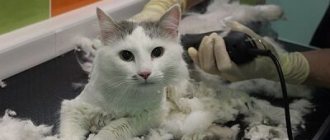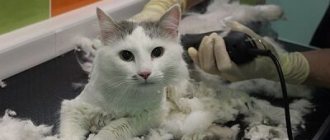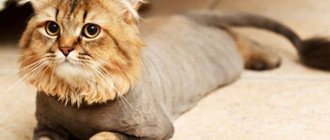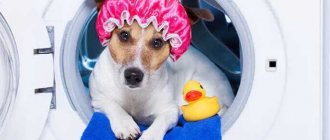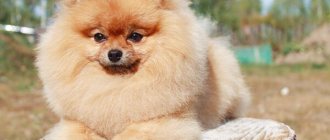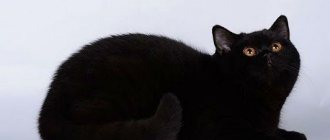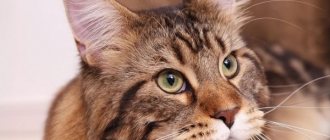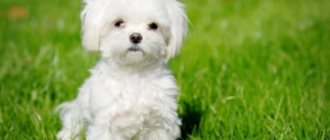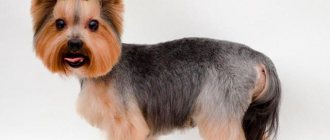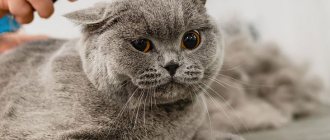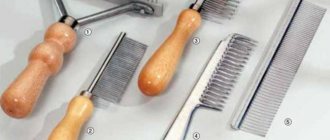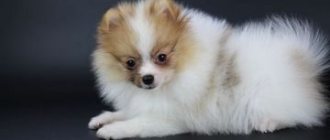Popular types of haircuts
Giving a dog a fashionable haircut is not easy. Fashion for dog hairstyles is very fleeting and changes almost every season. Now, judging by the feedback from our readers, the following haircuts are popular:
- under a teddy bear;
- in Korean style;
- like a puppy;
- shaving like a chinchilla.
If a fashionable dog look does not seem impressive enough to the owner, then you can add a couple of colored strands or rhinestones to it.
Classic show haircut
To win the show, the dog must meet the breed standard as closely as possible. The length is practically not touched, the fur is slightly stretched and given a well-groomed appearance. The paws should appear round, so excess hair between the toes is removed.
An exhibition is a responsible event; if the owner is not very experienced in hairdressing, then it is better to entrust the preparation to a qualified groomer. A dog that is not cut to standard will most likely be disqualified.
Differences in haircuts for females and males
Dog haircuts, unlike human haircuts, do not have clear divisions into women's and men's. The groomer can offer the same hairstyle to both the dog and the bitch.
There are differences in the technique of cutting the genital area. Boys often have short hairstyles, leaving long hair only on the head. Girls are given a more feminine look and are often decorated with bows or rhinestones.
Description of Maltese
The Maltese is a good-natured dog with a gentle disposition that wins hearts. Graceful movements, aristocratic poise and refined features make the Maltese one of the most sophisticated dog breeds, surpassing even the Yorkshire Terrier in popularity.
It’s impossible not to fall in love with her appearance: miniature beady eyes filled with love, a mobile and inquisitive beady nose, a harmoniously built body and strong paws. But external beauty is complemented by an angelic character, boundless devotion and obedience.
The Maltese is a fairly expensive breed that has strict requirements. According to the international description of the breed, purebred Maltese dogs must have the following characteristics:
- Weight. Maximum threshold 4 kg.
- Height at the withers. For girls, height is allowed from 20 to 23 cm, boys can be a couple of cm taller, but not more than 25.4 cm.
- Color. Pure white coat color is considered the standard, but a slight shade of ivory is also allowed.
- Frame. The Maltese has an elongated body, without a pronounced slope to the croup. The Maltese's paws are of medium length, the tail is curved, tapering towards the end.
- Muzzle. Eye color is dark brown, round in shape. The nose and line of lips and eyes are black. The ears are small, triangular in shape, hanging. Scissor bite.
- Character. The peculiarity of the breed is confidence, friendliness, agility, and playfulness. But to a greater extent, character depends on upbringing. Maltese immediately choose one owner, and treat everyone else as equals. If a puppy is surrounded by affection and respect, he will remain obedient and faithful for the rest of his life. If in childhood he did not find a worthy owner, he becomes aggressive and very harmful.
- Wool. This is the real pride of the breed - it is thick, shiny, snow-white. The coat is without curls, it falls from the body and grows to the floor. The Maltese has no undercoat.
- Intelligence. Maltese is not distinguished by high intellectual qualities, but is very smart and inquisitive. She is willing to be trained and then follows the family routine.
- Security and guard potential. It’s difficult to call a Maltese a guard, but the lapdog’s attitude towards outsiders is unfriendly - it can bark and even bite.
Exterior
The breed standard of the Fédération Cynologique Internationale (FCI) classifies the Maltese as a group of toy dogs, a subgroup of the Bichon and related breeds. In addition to the Maltese, this also includes Bolognese and Bichon Frize.
Photo of an adult Maltese dog.
Maltese dogs look charming, both in person and in photographs. These are miniature dogs with a snow-white coat that flows down the sides, black beady eyes and a charcoal nose. They have smooth, refined movements and the manners of aristocrats.
The table provides a detailed description of the breed.
| Parameter | Breed standard |
| Height | 21-25 cm males, 20-23 cm females. |
| Weight | 3-4 kg. |
| Constitution | Developed, dry, without roughness. |
| Frame | Stretched out, with a long straight back and a short arched loin. The neck is of moderate length and holds the head elegantly. The chest is voluminous, long, in circumference equal to 2/3 of the dog’s height. The stomach is slightly retracted. |
| Head | The length reaches more than half the height at the withers. Proportional, wide, ovoid, with a convex crown and nape. The forehead is divided in the middle by a hollow. |
| Ears | They stand high, hanging, if the dog is alert, they rise. In the shape of a triangle with round ends. Covered with long hair, which smoothly connects with the fur coat at the withers. |
| Eyes | Large, round in shape, set low and moderately deep. The color is dark brown, the edging is black. |
| Nose | Small, black. |
| Lips | Dry, thin, black mucous. The upper lip hangs over the lower lip. |
| Bite | Scissor-shaped. |
| Limbs | Straight, muscular, parallel when viewed from the rear or front. Stand clearly under the body, elbows pressed to the chest. |
| Paws | Small, collected in a round lump. Richly covered with wool. The pads and claws are strong and black. |
| Tail | Stands at the height of the back, thrown back and pressed to the body on the left or right. Equal to 60% of the dog's height, trimmed with straight, flowing hair. |
| Wool | Straight, long, reaches 22 cm, spreads along the ground. There is no undercoat. A mantle flows down the sides. The hairs on the head are the longest, blending in with the hair on the ears and face. |
| Color | White, less often - ivory. |
Types of haircuts
The lush coat, which allows you to create original haircuts, is one of the reasons for the incredible popularity of the Maltese. But only non-show dogs can afford beautiful fancy hairstyles. Everyone else has to be content with the liberties that the standard allows.
Like a puppy
An excellent haircut option for the summer - “puppy style”. This option is also called “mouton” because of its similarity to the pile of popular fur. The main part of the coat is shortened with scissors; the clipper is used only as a means of hygienic care in the anal area. Long bangs, mustache, eyebrows remain on the muzzle, and the areas around the eyes are trimmed short.
The length of the coat on the body and paws resembles that of a puppy. The result is an easy-to-maintain and completely recognizable hairstyle that does not need to be updated too often.
Hygienic
Among the haircut options for Maltese, the hygienic one confidently holds a leading position. It is ideal for pets and allows you to choose any length of guard hair. The list of procedures necessarily includes shortening hairs in the intimate area, between the paw pads
Veterinarians recommend paying special attention to trimming the hair inside the ear - in this case, you can ensure compliance with hygienic requirements and avoid the development of an inflammatory process
When designing a hygienic type of Maltese hairstyle, various liberties are allowed. This includes coloring with special means that can significantly diversify the look of your pet. But it is also possible to use a machine that shortens the coat throughout the body as evenly and efficiently as possible.
Kawaii
Korean-style haircuts are a popular option for grooming your pet Maltese. It is also called “kawaii” (toy) and is considered a legacy of anime culture. Grooming involves keeping the fur on the surface of the muzzle very short and shaving the cheek area. Long hairs are retained behind the ears, and a cap or long tail is left on the surface of the head.
The surface of the neck is also cut very short; recommendations for the length of hair on the body and paws are left to the discretion of the hairdresser
It is worth paying attention to the fact that most often the body remains almost naked. But the surface of the paws retains fluffy fringes
Under a teddy bear
Another variant of the Korean style offered by groomers for Maltese. The teddy bear haircut is reminiscent of the “mouton” option. The hair on the body is shortened to 5 cm, the length on the head and muzzle is the same, the ears are also trimmed quite short, and most of the hairs inside are removed. Thanks to the correct execution of the haircut, the dog’s appearance becomes “plush”, toy-like and cute.
Exhibition
Caring for Maltese fur for exhibition requires a particularly careful approach to the matter. The length of the coat should be maximum - 5-10 cm greater than the height of the dog at the withers. The ends of the guard hairs are trimmed to form a beautiful and clear line. Excess hair is removed from the paw pads and anal area. A top note is formed on the head - ponytails, forming a clear and even parting, reaching to the croup.
In preparation for the exhibition, the owner of a Maltese dog has to master the use of curlers, which allow them to grow the desired length. Before curling the hair, the coat should be lubricated with special oil and soaked in masks and sprays. Individual curls (according to the width of the curler) are wound and secured with elastic bands.
Varieties of hairstyles - from classic to original
The breed standard specifies that in order to participate in competitions, a Maltese's coat must be 5-10 cm longer than the height at the withers. In this case, the snow-white mantle in a static position forms a clear silhouette. Grooming a lap dog for participation in exhibitions should emphasize the animal's advantages and hide its shortcomings.
There are many other hairstyles for dogs purchased as pets. Fashion here is very diverse, the most popular are:
- like a puppy;
- kawaii;
- under a teddy bear;
- hygienic.
The lush coat allows you to create various original images. The unlimited ability to change appearance is one of the reasons for the great popularity of the Maltese.
Types of Maltese haircuts
Experts offer several basic options for grooming Maltese dogs:
Exhibition haircut. In this case, the length and quality of the pet’s coat is decisive. Groomers do not shorten the coat, but only give it a well-groomed appearance, trimming the contour and giving the outline of the animal’s body a harmonious appearance. In an ideal show cut, the hair on the head is gathered into top notes (tails) that flow smoothly into a parting along the entire length of the body. Great importance is attached to hygiene procedures performed at the stage of preparing a dog for an exhibition. Cleaning the ears, trimming the hair between the toes, between the pads of the paws, and also in the groin area is included in the mandatory minimum for caring for the dog. In this haircut, the hair between the eyes is not cut.
Maltese puppy haircut (Mouton). It involves the use of scissors to shorten the coat, and the machine is used solely for the purpose of performing hygienic manipulations. After performing the manipulation, the contours of an adult dog resemble a teenager. This is precisely what explains the name of the summer “puppy” haircut. It can also be performed in winter, but you will need to purchase warm clothes to avoid hypothermia and prolonged illness of your pet. In most cases, the specialist leaves the hair on the legs and body the same length, and on the face he only trims the bangs, eyebrows and mustache, making them slightly longer than on the rest of the body.
A hygienic haircut is indispensable for owners who do not accept a puppy haircut, but also do not plan to participate in exhibitions. The coat can be shortened according to the wishes of the breeder, and also dyed in various shades with special dyes. An “intimate haircut” is required, as well as hair removal between the toes and between the paw pads. Veterinarians remind you of the need to remove hair from the inner surface of the ear, as this can lead to inflammatory diseases as a result of the accumulation of wax and the addition of a secondary infection. Nail trimming, oral care and cleaning of the anal glands should also be carried out regularly, which allows you to maintain the animal in impeccable condition.
The Korean Style haircut involves greatly shortened hair on the pet's face and shaved cheeks. Longer strands are left behind the ears and on the back of the head. They can be shaped like a cap or a ponytail. The neck is also cut quite short, but the length of the hair on the body does not have strict restrictions and it all depends on the desire of the owner.
In most cases, the pet's fur grows back quite quickly. Therefore, you will have to visit the salon once every 1-1.5 months to perform hygienic procedures and once every 1.5-3 months to perform a high-quality haircut for your pet. When grooming a puppy, it is enough to shorten the coat once every 3-4 months. But to maintain the impeccable shape of a pet with a show haircut, you need to visit the groomer 2-3 times a month.
Diseases
Unfortunately, this breed has a considerable list of diseases. These cute dogs suffer from diseases of the eyes, teeth, heart, stomach, as well as eclampsia and allergies. It is important to know the decoding of symptoms in order to properly help your pet.
Symptoms
Urine with blood
An alarming situation is when the lap dog is hiccupping and blood is released in the urine. This indicates possible cystitis or cancer in the dog. Without professional diagnosis and consultation with a doctor, it is impossible to identify the exact cause of these symptoms. Self-medication is strictly prohibited.
What to do when your eyes are running?
Glaucoma is the most common disease in which there is excessive tearing, strabismus, enlargement of the eyeball, blindness, and acute pain. Glaucoma is caused by a violation of the outflow of fluid from the chambers of the eye. The pressure rises, the retina is destroyed, and ischemia of the eye tissue occurs. You should consult your doctor immediately to get the right advice and treatment.
Seething in the stomach
This is an upset stomach. Caused by illiterate feeding, for example, a combination of dry food with natural food. Usually the dog refuses food for several days . But after a meal, stool appears with a large amount of elastic mucus. You should choose one type of food and make your pet drink more boiled water. Medicines are prescribed only by a doctor.
Gases
This is flatulence, which has similar symptoms and causes of appearance with seething in the stomach. However, gases can also be caused by poisoning.
Treatment
Prevention of diseases is the best treatment. The action plan is as follows:
- undergo an oral examination 2 times a year;
- carry out annual sanitation of the Maltese’s oral cavity;
- undergo echocardiographic examination 2 times a year;
- regularly measure intraocular pressure.
If your dog suddenly becomes lethargic, apathetic and refuses to eat, then immediately visit a veterinarian. Only a specialist will determine the exact cause of the ailment, announce the diagnosis and prescribe treatment.
Attention! When walking with Snow White, you need to carefully monitor her behavior. You should not allow the dog to eat from the ground, eat unknown grass, and so on. Otherwise there is a risk of poisoning.
Types of Maltese haircuts
Experts differentiate between exhibition and everyday haircuts.
For a pet to participate in shows and shows, the closest attention is concentrated on the texture and length of the coat. The long, flowing awn envelops the dog in a flowing, precious mantle
The breed standard clearly indicates the length of the coat: it “exceeds the height of the dog at the withers by five to ten centimeters.” The task of exhibition grooming is to maximally emphasize the advantages and characteristics of the Maltese and hide (smooth out) minor flaws in the exterior.
When keeping a pet “for the soul” in the absence of exhibition activity, for everyday life, when the owner is not able to carry out the most complex care for floor-length hair (washing, combing, curling with curlers), owners prefer short haircuts for Maltese dogs. Everyday haircuts are divided into hygienic and designer hairstyles.
Exhibition classics
A clipped Maltese dog must meet all the requirements of the breed standard. This is filigree, jewelry magic. It is strictly forbidden to touch the length: the groomer does not cut it, but only gives the coat the proper appearance with the lightest strokes of the scissors. The fur is smoothed out, damaged ends are trimmed, smoothing the edges of the mantle, giving the silhouette a stylish look.
A classic show haircut: top notes gathered on the head (ponytails) turning into a perfectly straight parting along the entire length of the body.
A lot of attention and trouble is paid to hygiene procedures: cleaning the ears (including trimming the ear canals) and trimming the hair in the groin area. Preparation for the exhibition does not include trimming the fur around the eyes.
A show is an important and serious event; inexperienced owners would be better off spending time and money on a visit to a professional grooming center. Exhibition haircut of a Maltese is a complex procedure, full of hidden subtleties and details.
A Maltese cut in violation of the canons and standard requirements will certainly be disqualified.
Hygienic haircut
This haircut option is intended only for non-show Maltese dogs. Everything is clear from the name: making life easier for the owner (care is minimized) and the everyday life of the pet (spending days and nights in curlers and curlers is hard labor even for a dog). The grooming center specialist will fulfill any wishes of the owner: he will shorten the fur as much as possible along the entire length of the body, trim the genital area and anus.
Some “progressive” salons, following fashion, include in the price list of their services the coloring of the Maltese in “any color and shade” with special dyes.
With a certain persistence and desire, having received advice from an experienced groomer and a little practice, a hygienic haircut is quite possible at home by the owner himself. A simple haircut with a “no frills” clipper to a minimum level, almost “to zero” is ugly, but practical and cheap.
Maltese puppy haircut (mouton)
Mouton is a neat haircut with scissors followed by “grinding” with a machine using attachments of different lengths. A puppy-style haircut for a Maltese dog changes the silhouette of the dog: the adult contour is replaced by the outline of a teenage dog.
The “mouton” haircut of Maltese dogs is very popular on the eve of the summer season: the dog can tolerate the heat more easily, and the owner’s efforts to care for the rich coat of the Maltese are significantly reduced. In winter, puppy grooming of doggies is also possible, but you will need to replenish your pet’s warm wardrobe.
Maltese haircut in kawaii style
Designer haircuts for Maltese dogs are the widest field for implementing the most unusual fashion trends. It is now difficult to surprise anyone with the usual “poodle” and “lion” haircuts. The Korean-Japanese “Maltese kawaii” trend rules the roost, creating a unique image that stands out from the general background.
Experts insist that fashionable style is a projection of popular Japanese cartoons. The term “kawaii” translates as “cute toy.”
The muzzle is cut short, the cheeks are shaved down to the skin, the entire length of fur is left behind the ears and in the back of the head.
A cut “kawaii” Maltese certainly attracts attention and causes, if not delight, then amazement
Like most designer haircuts, kawaii haircuts require regular maintenance. The coat of lapdogs grows unevenly: after a couple of weeks, the ideal silhouette line loses its clarity. In this situation, there are only two solutions: the owner mastering grooming techniques or regular, expensive visits to the salon.
Why do you need to cut your Maltese?
In principle, the dog does not need to be cut, since breeders deliberately bred this breed with such a long and rich coat. Untrimmed dogs with a luxurious coat, cleanly washed, lubricated with balm and carefully combed are welcome at shows. Until the moment they are shown in the ring, show dogs sit in cages on pillows, since anything can stick to their fur, and the “hairstyle” will become tangled, matted, and dusty.
Dogs can be kept in the same condition, with their fur intact, at home. for convenience, they are dressed in overalls for a walk, and after the walk they carefully comb out any possible dust and dirt.
It is absolutely wrong not to walk your dog outside, fearing for its fur. Like any dog, the Maltese needs communication with its relatives, new experiences, fresh air and active movement.
If the Maltese is not shown in the show ring, it is clipped for convenience and ease of grooming.
It is preferable, of course, to remember that this is still a long-haired breed, and to cut the dog so that the long hair does not interfere with its walking and running, but at the same time the haircut does not change the appearance of the dog. In this case, the hair is trimmed flush with the paws, and part of the hair length is removed from the head so that the eyes are open. To maintain cleanliness, trim the beard slightly.
A slightly shortened coat requires the same careful care as an untrimmed coat.
To make it less dirty and not fall off, it is convenient to twist it into curlers using soft elastic bands or braid it.
Owners who do not have the time or desire to brush their Maltese often and for a long time choose short haircuts for their pets. So, the Maltese puppy cut is very popular. It makes the Maltese look like the Bichon Frize, Coton de Tulear and even the West Highland White Terrier. In a word, on anyone, but not on a Maltese.
Of course, any breed expert will tell you that there is nothing better than a Maltese that wears its coat and looks the way the breeders intended. But if you choose between an unkempt, long-haired dog and a neat-looking, trimmed one, then, obviously, the second option is much preferable.
British longhair cats
The British Longhair is considered a semi-longhaired variation of the British Shorthair. In Europe, this breed is increasingly called the Highlander or Britanica, but in America it is better known as the Lowlander.
And although fluffy British cats with long hair have existed for a long time, they were officially recognized only in August 2008, under the WCF system at the General Assembly. Until this time, long-haired kittens that were born from short-haired cats were considered PET. Such kittens could not be crossed with their short-haired counterparts and should not be allowed to be bred.
However, over time, lovers of the breed were still able to achieve recognition of the long-haired British bear-type not only in the WFC felinological association, but also in TICA. This type of breed is not yet recognized in other organizations, but is considered experimental.
The main difference and feature of a long-haired British cat from a short-haired one is the medium-length hair, which often increases from head to tail. Regardless of whether the cat is blue, chinchilla, or black Briton, the coat always has a double, ivy-like structure and dry guard hairs. In addition, if the pedigree of a long-haired British cat does not contain Persian cats, then its fur will never become tangled and therefore the care and maintenance of a British cat will not require much time. And these cats are completely unpretentious when it comes to food.
How to name a British kitten >>How to name a kitten based on the length of its fur >>
Nutrition
In order for the Maltese dog to develop properly, to be full of strength and energy, and to maintain health for many years, it is best to give it special dry food. Its manufacturers guarantee the balance of all components and compliance with all the necessary proportions of microelements and vitamins in it.
It is advisable to consult a veterinarian and check reviews about the manufacturer before choosing food. In addition, it must be selected according to age and individual characteristics.
But there are dog owners who do not trust dry food and prefer to prepare food for their pets themselves. In this case, the main thing is not to forget to add the necessary minerals and vitamin complex to the dog’s diet. This will help keep your dog in great shape.
Maltese dogs can be given poultry, beef, chicken eggs and various vegetables. Mixes and mixtures can be made from these ingredients. In addition, fish is sometimes introduced into the diet, which must be pre-cooked. Various cereals are also served with fish. For example, buckwheat or rice.
In addition to what to give your dog, you also need to know how to do it correctly. It is not recommended to keep a bowl of food on the floor all the time, that is, put a portion on the floor. After eating, he cleans up and washes himself. Next time everything is repeated again.
In addition, it is better not to leave food in the dog’s plate in reserve. Meals should be on a schedule. Adults need to break their food intake into 2 stages. At the same time, in the morning, porridge is given with milk, water or meat broth with the addition of pieces of chicken or beef.
Maltese puppy
In the evening - mixes of meat and vegetables, as well as eggs or fish. Portions should be small so that the dog does not gain much weight. Since this will have a bad effect on the functioning of her internal organs. In addition to standard dishes, the Maltese dog can sometimes be rewarded with treats. You can buy them in specialized stores.
Types of Maltese haircuts
The differences in haircuts by gender in the case of the Maltese are very subjective; there is no clear distinction. Most owners choose shorter haircuts for males and longer hair for females, but this is a personal choice for each owner. Even male Maltese dogs have bows pinned to their bangs, but in dark, boyish colors.
Hygienic
A hygienic haircut is created with the goal of providing the pet with maximum comfort in everyday life, and for the owner to simplify the daily care of the dog. The basis of this type of fur treatment is the removal of long hairs around the anus and genitals, between the paw pads and on the belly. In other places, they do as desired - you can either shorten the wool a little or make it as short as possible using a machine. This is the most popular haircut option due to its variability; it can also be used for show pets, but only outside the show season.
Hygienic grooming involves shortening the coat for the convenience of the owner and the dog.
Home (everyday)
With dogs that temporarily or do not participate in exhibitions at all, owners are happy to experiment, creating the most unusual images. There are several popular options for Maltese haircuts:
- Like a puppy. This type of haircut is done with scissors over the entire body of the dog. They shorten the main part of the fur, making longer hairs only on the ears, bangs and muzzle. The area around the eyes is cut short. The result of the haircut is an adult dog that resembles a puppy that has not yet acquired long hair. This option is often suitable for the summer, allowing the dog to feel more comfortable in the heat, but having done this haircut in the winter, you will have to additionally insulate the pet with clothes during walks.
A puppy cut is shortening the coat to create an overall fluffiness, like that of small lap dogs.
- Kawaii (the style is also called Japanese and sometimes Korean). The haircut involves creating a toy-like appearance: the neck, body, cheeks and eye area are cut short, while long hair is kept on the forehead, ears, paws and tail. The kawaii style requires constant care, the guard hairs grow unevenly, so you will have to trim them regularly, otherwise the image will be ruined.
Kawaii style makes the dog look like a toy
- Under a teddy bear (plush). The plush style is reminiscent of a puppy cut, but in this case the length is maintained throughout the entire body of the animal (usually about 5 cm). The ears are trimmed short, removing most of the hair inside.
Thanks to this technique, it is possible to make a lap dog look like a teddy bear with a round face.
- Clipper cut is a short clipper cut. This is one of the best options for the summer - the dog’s fur remains as short as possible, which makes it easier in the heat.
Clippercut - the shortest clipper haircut for a lapdog
There are a lot of designer haircuts, for example, poodle or lion, which allow you to give your dog an unusual appearance. It is not uncommon for the snow-white coat of a Maltese to be specially tinted - any colors turn out bright and saturated against such a background.
Exhibition
For exhibition, the coat cannot be shortened too much - it should reach the ground and stretch a little along it. Therefore, before the event, a haircut involves only minor intervention:
- trimming the edges of hairs;
- thinning hair around the eyes;
- removal of a small part of hair near the genitals and on the paws.
In other places, the wool is not touched with scissors, but the preparation usually does not end there. Maltese are decorated in every possible way, making their hair for the exhibition with various hairpins and decorative elastic bands. The most popular design option for bangs is a topknot ponytail.
Show cutting only involves trimming long hair.
Coton de Tulear
The second name of the breed is Madagascar Bichon. The Bolonki Islands arrived from France in the 17th century.
There is a legend that after a shipwreck near the port of Tulear, several dogs survived and bravely swam across the rest of the strait and ended up on the island, where they mixed with aboriginal mongrels. This is how we got the unyielding, brave, fearless Bichons - Coton do Tulear (the first part of the name translates as “cotton” from French)
Like all Bolonki, Cotons are small (up to 28 cm at the withers), stocky, dense, but graceful and graceful, with long ears, a high tail and a royal posture. Their distinctive feature is long gray or ashy spots among the curls of flowing, wavy white coat. Due to their short, thick limbs, Tulears have to jump with four legs rather than two.
Animals will follow their master into fire and water. They are ideal companions with good physical fitness, hardy, courageous and cheerful. Dogs know how to adapt to their owner: they are ready to entertain children, relax with an elderly person, go for a run in the morning or lie on the couch all day.
The breed is hardened by hot climates and work, so Cotons still exhibit survival instincts to this day. They can strangle a rodent or bark at a stranger
It is important for them to protect the owner and his property.
Dogs are valued for their intelligence, willingness to train and learn. But if training is not started on time, puppies become fearful, withdrawn and uncommunicative. The average cost is 35,000 rubles.
Grooming Maltese in the salon
It is very important to provide your lapdog with high quality grooming. Some procedures, such as brushing teeth and ears, can be done at home
Specialists should be entrusted with more complex actions such as thinning the coat and shortening it to a certain length. A set of procedures is not cheap, but often a visit to the salon is the only way to prepare a pet for an exhibition, help it reveal itself in all its glory, and instantly impress all members of the jury.
Note! The Maltese's coat grows very quickly, so the style can be changed quite often.
In addition, when visiting the salon, you can order exactly the hairstyle that, in the owner’s opinion, best suits your beloved Maltese dog. One breeder thinks the Maltese's puppy cut is ideal, while another is delighted with the Korean style. Experienced hairdressers-stylists can easily cope with any task, as they not only have all the necessary equipment and consumables, but also considerable experience.
Korean haircut
At the same time, the owner can be sure that the dog will not experience discomfort - employees of specialized salons know exactly what needs to be done to make the visitor satisfied.
Hygiene and care
The coat of any dog needs to be carefully looked after, which means you need to know the basic rules for caring for your Maltese. Let's look at each rule separately.
It is advisable to teach your puppy to handle hair from an early age. Grooming is a complex of caring procedures. Care concerns the dog’s fur and paws, on which the beauty of the pet largely depends. Therefore, you need to accustom your Maltese to brushing its teeth and ears, trimming its claws and fur.
Regular professional grooming of Maltese dogs includes the following procedures:
- Combing. Thick fur constantly gets tangled, lumps and knots form, so it is necessary to comb your pet’s hair every day.
- Washing the fur. Water procedures are permissible only after thoroughly combing the coat using cosmetics for dogs with light hair. The use of shampoos intended for humans is prohibited. You can decide for yourself how often to bathe your Maltese, it all depends on the physiological characteristics of your pet.
- Grooming a lap dog. You can cut your hair as desired or necessary. The frequency of the procedure may vary.
- Daily hygiene procedures, which include shortening nails, cleaning ears and teeth, and eye care.
Pets must be constantly looked after, and this applies not only to the Maltese, but also to other breeds.
Grooming a lap dog at home
You can also care for Maltese fur at home. To do this, you will need to buy high-quality tools, study the rules and techniques of cutting, but the main thing is to hone your skills in practice.
Preparation for the procedure
Before cutting a Maltese, you need to bathe it with shampoo and a special balm for easy combing. Afterwards, the animal needs to be dried with a hairdryer in the direction of hair growth and combed, getting rid of all tangles. At this stage, the dog is completely ready for further grooming.
To fully groom your dog, you will need the following tools:
- combs and slickers for combing wool before and during the procedure;
- well-sharpened hairdressing scissors;
To cut a lap dog, you need to purchase high-quality professional scissors.
- clipper (it is better if the tool is specifically for animals, and not for cutting people, otherwise it may simply not cope with the delicate fur of a lapdog);
- nail clipper;
- cotton pads for ears.
Procedure for cutting
The haircut itself should take place in several stages:
- The dog needs to be seated on a surface that is comfortable in height for the groomer.
- It’s better to start with the bangs - move the desired length away from the eyes and cut off the cap.
Maltese haircut starts with bangs
- We trim or shave the space between the ears, making sure the result is symmetrical.
Stage two: cutting between the ears
- The next stage is cutting the back. Here you also need to focus on the desired length of the finished hairstyle. If you need to cut your dog’s hair as short as possible, then this result can only be achieved with a clipper against the growth of the hair; in other situations you need to work according to the growth.
After the space between the ears, a strip is cut along the spine
- Now you can process the sides, starting from the place between the muzzle and the ear, moving to the neck and further along the body.
At the next stage, the area between the muzzle and ear is trimmed.
- Once the sides are trimmed, the limbs can be processed.
After processing the body, you can start cutting the limbs
- The next stage is the tail. It is usually enough just to trim it a little.
During the haircut, you can trim the tail if desired.
- Be sure to remove excess hair between the paw pads and in the ear. At this stage, trim the claws and clean the ears with cotton pads dipped in warm water.
Be sure to remove excess hair from between the paw pads
- Now you can start trimming your ears. In order for everything to turn out smoothly, you need to comb the wool and pinch the line along which you plan to cut with your fingers.
- All that remains is to shape the muzzle. To make the lines smooth and beautiful at the end, thinning scissors are used along the edge of the cut.
At the last stage, all that remains is to trim the fur on the face
The algorithm for grooming a puppy is no different from caring for an adult dog. The only caveat is that babies are usually cut with scissors and not short, but only by trimming the ends and giving a beautiful shape to the coat.
Possible mistakes when cutting your own hair
It is unlikely that you will be able to cut your dog's hair perfectly the first time; this will require a lot of practice. The most common mistakes when cutting hair at home:
- Household scissors. No ordinary scissors, even well-sharpened ones, will give a beautiful cut on a dog’s fur - they will tear it, wrinkle it and pull it. It is necessary to invest in a professional tool that will be convenient to use.
- Lack of example. The best option is to take your dog to a professional for grooming several times and observe his actions. Then your independent haircut will be more confident and of better quality.
- Household hair clipper. An ordinary machine, especially if it is expensive, simply will not take the delicate hair of a lapdog. It is necessary to purchase a tool designed specifically for cutting animals.
- Radical solutions. If you have a fluffy dog, you should not immediately go to extremes and cut it very short - there is a high probability that the result will not suit the owner and will create stress for the animal. It is better to start with light, hygienic haircuts and, if necessary, gradually shorten the animal’s hair to the desired length.
Show Maltese dogs are usually not cut short; a long, well-groomed coat is important to them. But pets outside of show activities are often given hairstyles, ranging from simply trimming long hair to completely cutting it off.
Tools, accessories, preparations. Prices for salon procedures.
For home grooming you need to purchase the following tools:
- tangle cutter;
- furminator;
- machine with attachments;
- thinning and straight scissors;
- metal combs;
- crest;
- wool polishing brush;
- nail clipper;
- hairdryer
To keep grooming accessories clean, you will need a disinfectant. During the procedure, periodically treat your hands with antiseptics.
To wash and give the wool a well-groomed appearance you will need:
- whitening shampoo;
- Coconut oil;
- balm;
- moisturizing shampoo;
- styling mousse;
- spray for grooming;
- hygienic ear drops;
- means for lightening tear tracks.
Use only professional products, they are expensive, but the effect will be appropriate . If you wash your lapdog with regular shampoo, the fur will most likely become tangled and stop shining. Using cheap products can lead to the formation of tangles.
The price for a set of procedures in the salon will differ depending on the city where the owner and the animal live. On average, creating a new image will cost the owner 1200-1500 rubles.
How to choose a haircut for a Maltese
The Maltese gives the impression of being an elegant, well-built, graceful and proud dog. Her whole appearance breathes severity, despite her doll size and very lively character.
If the owner decides to cut it, he must choose a haircut for the dog that does not make a doll out of the animal and does not make it look like a representative of some other breed.
Despite the fact that the most significant features of the breed are recorded in the generally accepted standard, all dogs are different from each other,
Some have longer legs, while others have short ones.
Some have a slightly elongated muzzle, while others have a snub-nosed, slightly flattened muzzle.
One dog has more clearly defined cheekbones, while the other has deeper-set eyes.
In other words, a haircut is selected for a particular dog as individually as a suit is for a person.
The first haircut of a Maltese at home or on the road should be carried out by an experienced groomer who has already cut Maltese dogs and has an understanding of the characteristics of their coat and the methods for choosing a haircut.
In general, it is best to entrust haircuts and hairstyles on such complex wool to a professional. Unsuccessful experiments with cutting your Maltese on your own will bring complete disappointment and even make the dog a little monster in the eyes of others.
Origin story
The Maltese dog (Maltese) received its name from the Semitic “malat” - “refuge”, a derivative of the word “melita”. Many islands and seaports were previously called this way.
Do you want to get a Maltese?
Yes 22.22%
I'm still thinking 33.33%
Has already! 44.44%
Presumably, the Maltese breed originated on one of these islands near Dalmatia. Previously, their homeland was called Meleda, today it is Mljet.
However, the exact origin of the dogs is not known. Their ancestors probably lived in the port cities of the Central Mediterranean and exterminated rodents.
While historians argue about the origin of the Maltese, no one doubts their antiquity. The first mention of the breed dates back to the 6th century. BC e. Figurines and images of dogs were found during excavations in Ancient Egypt, Greece, and Rome.
In the 1st century n. e. Maltese dogs came to China along with merchants. And in the Middle Ages - to Europe.
Even in ancient states, Maltese were the favorites of the nobility and monarchs. And from the 23rd century they completely migrated to palaces. The history of the breed marks the peak of popularity in the 16th century. The dogs were the favorites of Philip II, Mary Steward, and Elizabeth I.
In the same 16th century, there was confusion with the name. Until the 3rd century, Meleda was called not only an island off the coast of Dalmatia, but also Malta. Without understanding the origin of the dogs, they were dubbed Maltese or Maltese.
In Russia, they learned about the Maltese in 1812, during the Patriotic War with France. During the retreat, the French left behind several decorative dogs, which they called “French lapdogs.” However, the breed's exterior was lost: the pets were crossed with local dogs.
The first Maltese exhibition was held in Birmingham in 1864. Snow-white angels fascinated dog handlers: they recognized them as a separate Italian breed and developed a standard. And in 1873, an English club for Maltese lovers opened.
In Russia, the breed was introduced in the 20th century. The first representatives were brought from Czechoslovakia. But breeders made mistakes in breeding, and by the 80s. There are no Maltese dogs left that meet the requirements of the standard.
Now the situation is improving. The breed is actively bred in the CIS countries, nurseries and clubs have been founded. However, the Maltese remains one of the rarest and most elite decorative dogs.
What is the difference between cutting a “girl’s” haircut and a “boy’s” haircut?
In order for a dog to look attractive, in addition to professional grooming, it needs daily care, which the owner can provide for it himself. Experienced dog breeders even draw up special schedules in which they indicate on which day the dog has a haircut and on which day it has a bath.
Professional breeders recommend accustoming your dog to grooming procedures from an early age. Both a puppy and an adult lap dog must endure without fear or aggression:
- washing paws after a walk;
- bathing;
- hygienic haircut;
- cleaning ears, eyes and teeth;
- trimming nails;
- winding wool on curlers.
Each owner chooses how to cut a dog's haircut himself. The only thing he should know is that certain requirements are put forward for the appearance of animals that take part in exhibitions. So, the Maltese’s coat should not be 5-10 cm longer than the height of the dog itself at the withers. When moving, it should flow; when the dog is calm, the hair should beautifully frame its silhouette. Lap dogs, which for one reason or another do not take part in exhibitions, can look the way their owners want.
When a dog enters exhibitions, the thoroughness and scrupulousness of the process is very important. Dogs with soft fur are groomed once a month. But everyday haircuts can be done at home. In other cases, contact a groomer - a “dog hairdresser”: he will perform a haircut of any complexity quickly and professionally.
There is a natural difference in trimming hair in the genital area of females and males. The hair on the male's head is cut mostly short, but the female is left with long locks, sometimes braided in the form of braids. But “puppy” haircuts are not suitable for “girls.”
In the area of the genitals and buttocks, the hair is shortened - this will allow the lapdog to avoid inflammation from lack of access to open air. Hair on the belly and in the area of the paw pads is also removed. Substantial hair removal up to the scalp will keep your dog comfortable in hot summer weather.
Breed characteristics
Although the Bolognese's long history began with a career as a rat catcher, it had virtually no influence on the character of these dogs.
Bologneses absolutely cannot stand being alone.
For much longer, the lapdog was a resident of rich mansions and estates, the most beloved animal in noble families, where the owners kept entire kennels of hunting dogs.
As a result, the little pet learned to make friends with numerous pets and truly become attached to its owners.
The most distinctive feature of Bolognese is the absolute inability to be alone. The dog perceives the absence of people as a personal tragedy, loudly protesting against it. The owner of a dog of this breed must constantly be close to his pet, and not leave him alone for more than a couple of hours, otherwise the surrounding area will be filled with sorrowful barking.
The delicate nervous organization of representatives of this breed is the cause of all kinds of somatic diseases. The dog mopes when little attention is paid to him, even if the owner is nearby. But if the Bolognese feels care and love, then he is always in a good mood, loves to entertain his household with various tricks and tricks, which he is a great master at inventing.
The Bolognese is an ideal apartment dog; it does not require much physical activity, but representatives of this breed will happily run around in the park or accompany their owners on a hike. They tolerate heat and cold well, are quite hardy and do not consider themselves gentle creatures at all.
The small size and apparent fragility of the Bolognese does not prevent it from bravely rushing to protect the home or owner if they are in danger. A piercing, loud bark is the main weapon of a guard, and so that the pet does not annoy the family day and night, reacting to the slightest noise, it needs to be taught the rules of good behavior. Bolognese bravely protects his owner and home with his ringing bark.
Bolognese bravely protects his owner and home with his ringing bark.
Subtleties of training
Without timely education and training, a cute, charming Bolognese puppy will grow into a dog with a disgusting character. The dog, considering himself the center of the Universe, attacks household members and people he knows, threatening them with sharp white teeth. To avoid this transformation, the puppy needs to be introduced to street noise as early as possible and taken to crowded places.
Friends who come to the house, neighbors and just passers-by can be asked to communicate with the dog, pet him and treat him. Only with timely socialization will a tiny puppy grow into a charming and friendly adult dog.
The Bolognese is a dog breed that is highly trainable, and the dog is easy to teach not only various commands from the general training course, but also interesting tricks. Dogs of this breed are excellent at training and perform successfully in agility, obedience, and freestyle. The owner, using the dog's strong affection and desire to please, can teach him many household tricks.
